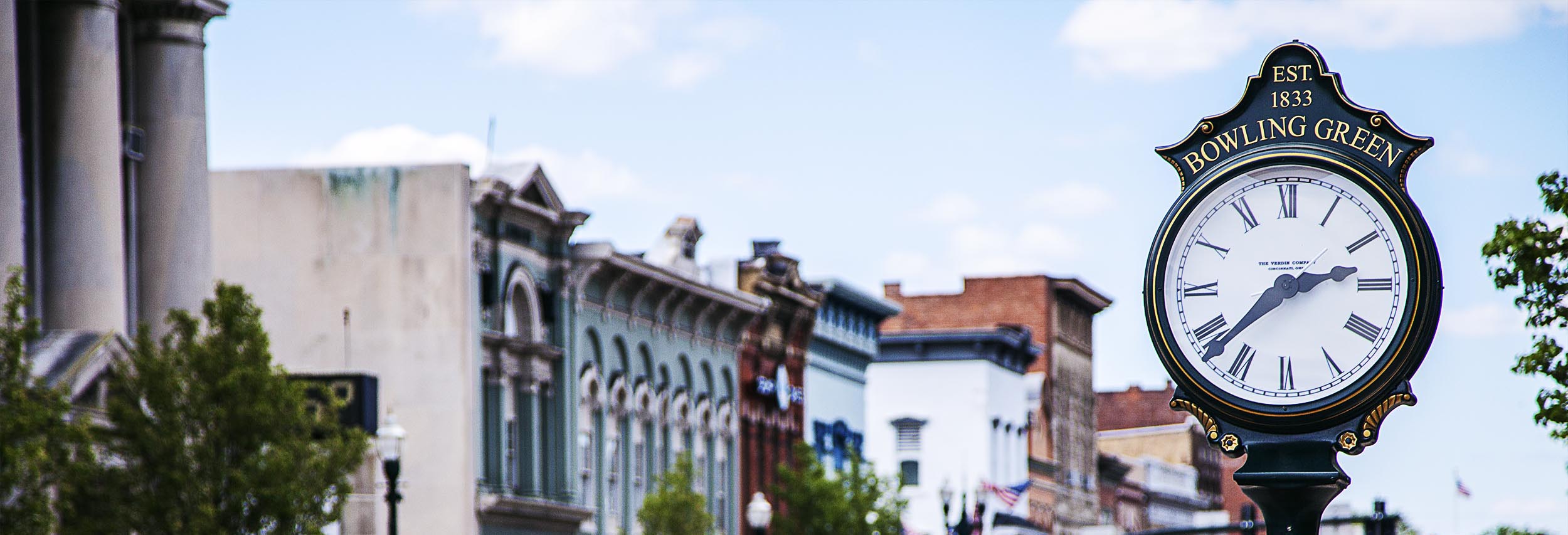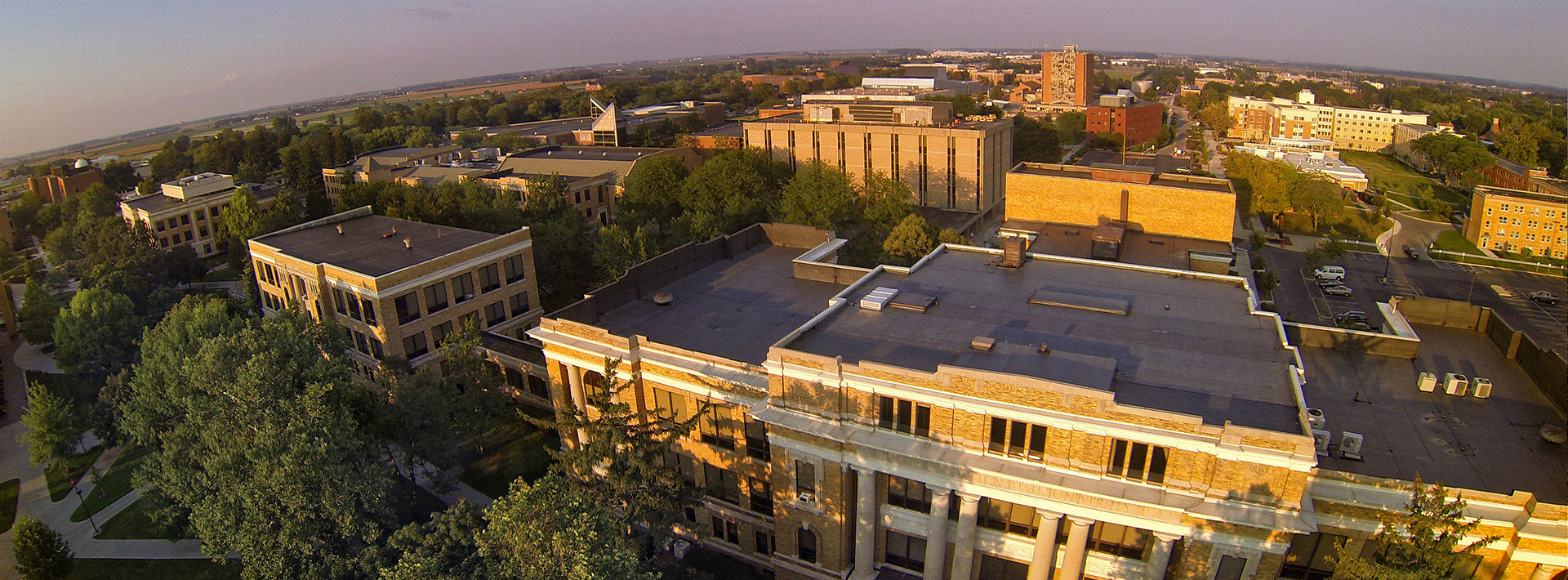Counseling Center Overview
Bowling Green, Ohio

The city of Bowling Green, Ohio, population 29,600 (including students), is located in northwest Ohio about 20 miles south of Toledo. Bowling Green State University's personal atmosphere is enhanced by its physically compact campus located within the Bowling Green community. Most restaurants and businesses are within walking or biking distance of the campus.
Outdoor recreational activities are readily available, including the beauty and recreational opportunities of Lake Erie. Camping, hiking, biking, canoeing and other outdoor activities are merely minutes away. However, Bowling Green is also within a comfortable driving distance of all major cities in Ohio (Toledo - 30 minutes, Cleveland - 2 hours, Columbus - 2.5 hours, and Cincinnati - 3 hours). In addition, Detroit, Michigan is less than an hour and a half away, Ann Arbor, Michigan is one hour away, and Chicago is a four-hour drive.
Bowling Green State University

Bowling Green State University combines the personal atmosphere of a small college with the opportunities of a major university. With more than 200 undergraduate majors and programs, our learning community provides high-quality faculty members who care about their students, an appreciation for diversity, and the latest in information technology. Integral to campus life are the core values: respect for one another, collaboration, intellectual and personal growth, creativity and innovation, and pursuit of excellence.
Counseling Center Overview
The Bowling Green State University (BGSU) Counseling Center is the primary psychological service facility on campus. Administratively, the Counseling Center is part of the Community of Care, which is within the Division of Community and Well-being. The Counseling Center is accredited by the International Association of Counseling Services (IACS) and is a member of the Association of Counseling Center Training Agencies (ACCTA), the Association of University and College Counseling Center Directors (AUCCCD), the Association for University and College Counseling Center Outreach (AUCCCO), and the Association for the Coordination of Counseling Center Clinical Services (ACCCCS).
Our multidisciplinary staff includes two full-time licensed psychologists and three doctoral interns. We also have a full-time AOD prevention specialist, five full-time counselors, and a full-time case manager. The Counseling Center staff adheres to the legal, professional, and ethical standards of the Ohio Psychology Law and Rules of the Board, Ethical Principles of Psychologists and Code of Conduct, and the Accreditation Guidelines of the International Association of Counseling Services.
Counseling Center Services
The Counseling Center provides brief, short-term individual counseling, group counseling, crisis intervention, and consultation. Our goal is to provide quality services, get BGSU students connected to the best mental health services to meet their needs, and reduce barriers to services for BGSU students. Counseling services are limited to enrolled BGSU students and are provided at no additional charge. Issues often addressed in counseling include depression; anxiety; interpersonal concerns; study/test taking concerns; stress/anxiety reduction; family concerns; eating disorders; sexual concerns; grief and loss; coming out issues; experiences of physical/sexual assault and other concerns.
The Counseling Center maintains liaisonships and collaborations with several offices across campus.
The Counseling Center is located at 101 East Hall and is open Monday - Friday from 8:00AM to 5:00PM. Extended hours are sometimes offered during the Fall and Spring semesters.
The mission of the Counseling Center is to promote the psychological well-being of students from diverse backgrounds; to foster their development, learning, and academic success; and to provide appropriate intervention when students are experiencing serious mental health concerns.
The staff accomplishes this mission by providing psychological consultation to the Bowling Green State University community, including its faculty, staff, students, and their families. The mission is also achieved through the provision of a variety of other psychological services, including assessment, counseling (group, individual, and relationship), case management services, alcohol and other drug (AOD) assessment and psychoeducation, crisis intervention, training, community consultation, on-line psychological resources, supervision, referral, and collaboration with psychiatrists as well as other medical professionals in Falcon Health to coordinate client care.
In providing such services, the staff of the BGSU Counseling Center strives to promote social justice and to demonstrate sensitivity to the diverse needs, backgrounds, values, and characteristics of our campus community.
The Counseling Center staff welcomes all students. We aspire to respect cultural, individual, and role differences. Our goal is to create a safe, supportive, and affirming climate for individuals of all races, ethnicities, national origins, genders, gender identities, sexual orientations, religions, ages, abilities, sizes, socioeconomic statuses, languages, and cultures.
The Counseling Center is administratively housed within the Division of Community and Well-being which consists of a variety of departments that promote a positive environment for student success. Services offered range from student conduct, recreation and wellness, accessibility services, and health-related services.
The Division of Community and Well-being complements Bowling Green State University’s mission to be the premier learning community in Ohio, and one of the best in the Nation. This is accomplished by the following practices:
- We enhance student learning and achievement through innovative programs, services, and facilities that meet students’ developmental, social, physical and psychological health, and academic needs and interests.
- We challenge and engage students by creating a supportive, learning-centered environment that encourages intellectual exchange, cultural literacy, self-assurance, respect for others, and the responsible exercise of individual expression.
- We strive, in partnership with Academic Affairs, to help students integrate learning experiences and develop competence in critical thinking, written and oral communication, interpersonal relations, and leadership. Achievement of these learning outcomes prepares our students for life-long personal and professional growth.
- Our aim is to prepare Bowling Green State University graduates for leadership in their communities, and meaningful involvement in an increasingly diverse, technologically sophisticated, and complex global society.
Characteristics of Counseling Center Clients
Client Demographic for the 2024-2025 academic year
The following information was gathered from the 2024-2025 academic year client Data Forms.
| GENDER IDENTITY | PERCENT (%) |
| Man | 29.4 |
| Nonbinary | 5.8 |
| Transgender | 2.3 |
| Woman | 58.9 |
| Self-Identify | 1.3 |
| Not Reporting | 2.7 |
| RACE/ETHNICITY | PERCENT (%) |
| African American / Black | 11.3 |
| American Indian or Alaskan Native | 1.4 |
| Asian American / Asian | 5.4 |
| Hispanic / Latino/a | 6.1 |
| Multi-Racial | 4.3 |
| Native Hawaiian or Pacific Islander | 1.0 |
| White | 82.5 |
| Self-Identify | 0.7 |
| Not Reporting | 2.4 |
| SEXUAL ORIENTATION | PERCENT (%) |
| Asexual | 4.0 |
| Bisexual | 16.0 |
| Gay | 2.4 |
| Heterosexual | 53.8 |
| Lesbian | 5.1 |
| Pansexual | 5.3 |
| Queer | 4.6 |
| Questioning | 2.7 |
| Self-Identify | 1.0 |
| Not reporting | 6.8 |
| RELATIONSHIP STATUS | PERCENT (%) |
| Single | 57.8 |
| Serious dating or committed relationship | 34.4 |
| Civil union, domestic partnership, or equivalent | 0.3 |
| Married | 1.3 |
| Separated | 0.3 |
| Divorced | 0.3 |
| Not reporting | 6.8 |
| RELIGION | PERCENT (%) |
| Agnostic | 14.7 |
| Atheist | 11.3 |
| Buddhist | 0.4 |
| Catholic | 13.8 |
| Christian | 29.4 |
| Hindu | 1.4 |
| Jewish | 1.0 |
| Muslim | 0.7 |
| No preference | 21.7 |
| Self-Identify | 2.1 |
| Not reporting | 4.7 |
| RELIGIOUS IMPORTANCE | PERCENT (%) |
| Very Important | 9.8 |
| Important | 20.1 |
| Neutral | 38.2 |
| Unimportant | 14.6 |
| Very Unimportant | 12.4 |
| Not reporting | 6.4 |
| ACADEMIC STATUS | PERCENT (%) |
| First-year undergraduate | 35.9 |
| Second-year undergraduate | 24.1 |
| Third-year undergraduate | 18.0 |
| Fourth-year undergraduate | 8.8 |
| Fifth-year or more undergraduate | 2.7 |
| Graduate / Professional degree student | 8.1 |
| Non-degree student | 0.3 |
| High school student taking college classes | 0.3 |
| Other | 1.0 |
| Not reporting | 1.4 |
| PERCENT (%) | |
| INTERNATIONAL STUDENTS | 3.4 |
| 1ST GENERATION | 23.1 |
| MILITARY SERVICE | 0.3 |
| REGISTERED FOR DISABILITY | 11.1 |
Updated: 10/21/2025 11:32AM
